Digital marketing in Italy is changing fast, offering many chances for businesses to grow online. The number of new startups in Italy has jumped to 14,708 by October 2022. This shows a 0.6% increase from the last quarter.
Italian brands are focusing on being real in their marketing. This approach leads to lasting success and inspires others worldwide. The government is also helping with the Italian Startup Act. It gives tax breaks and R&D credits, making it easier for digital services in Italy.
This changing scene opens up new chances for UK businesses. It also helps them understand and connect with Italy’s market better.
Key Takeaways
- Digital marketing is evolving rapidly in Italy, providing vast opportunities for businesses.
- The growth of innovative startups signifies a vibrant entrepreneurial spirit in the country.
- Authenticity remains a key factor for brands aiming for lasting success.
- Government support through initiatives like the Italian Startup Act fosters growth in the digital sector.
- Understanding local market nuances is essential for effective engagement.
- Investing in online marketing strategies can significantly enhance brand presence.
The Growth of Digital Marketing in Italy

Digital marketing in Italy is growing fast. About 50 million Italians, or 85% of the population, use the internet. This means around 33.3 million people bought something online in the last three months, as of Q1 2022. This shows a big shift towards online shopping and digital marketing in the country.
The COVID-19 pandemic helped speed up this change. It made many sectors turn to digital solutions, like online shopping and working from home. These changes are key to Italy’s economy.
Italy is investing more in digital services and skills. The government has plans to improve broadband and digital skills. This is important because only 45.7% of Italians aged 16-74 have basic digital skills. This is lower than the EU average.
Online shopping and marketing are set to grow. This is because more people want easy and quick shopping experiences. Brands and consumers are connecting more on social media. This shows the need for marketers to keep up with new trends.
Current Landscape of E-commerce in Italy
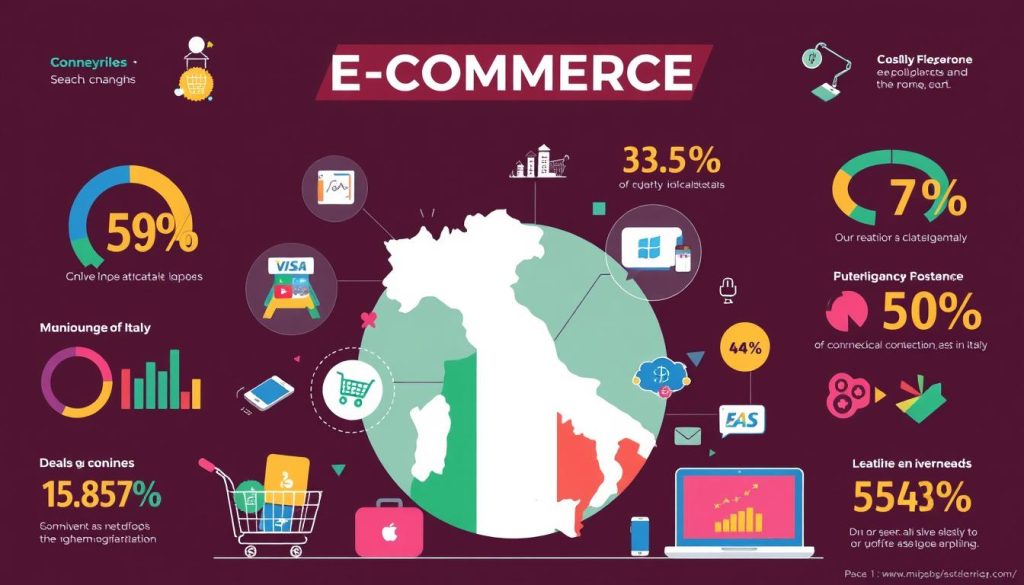
In 2022, Italy’s e-commerce sector grew to about €72 billion. This is a 25% increase from the year before. It shows the ongoing growth in online shopping and changing habits in Italy.
This growth means Italy’s e-commerce market is expected to hit €55 billion by 2023. It’s becoming a key part of the economy. More people are buying online, with 57% of Italians doing so in 2022. Also, 86% of the population has internet access.
Big names like Amazon, eBay, and Zalando lead the Italian market. This shows a strong preference for international brands. Despite this, cash is still used in 44% of all payments in Italy. Yet, over 50% of e-commerce happens on mobile devices. This shows a big shift towards digital shopping.
Digital Marketing Business Opportunities in Italy
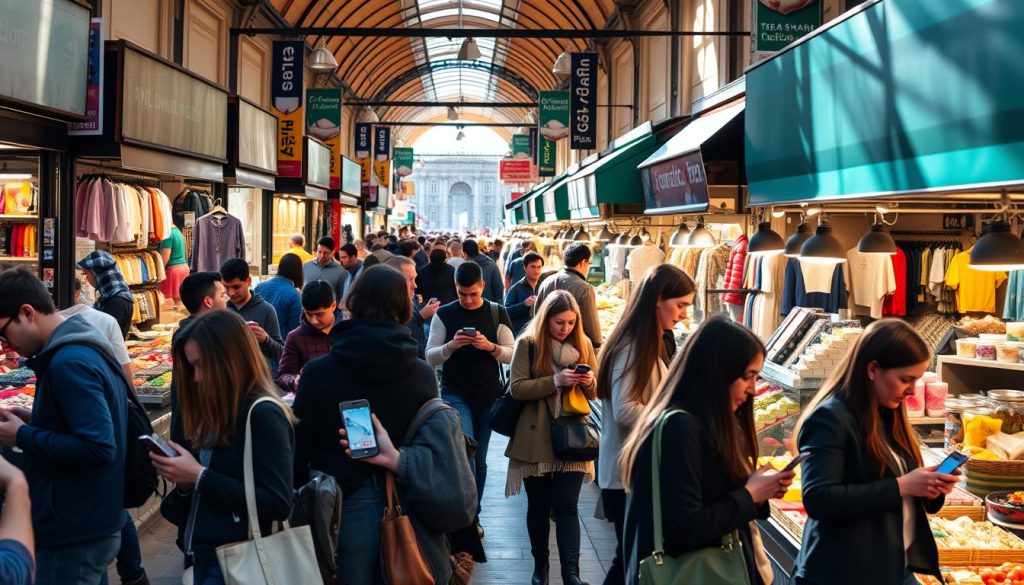
Italy’s digital marketing scene is complex but full of potential. It’s all about understanding how Italian consumers behave online. With over 44 million Italians on social media, their opinions shape what they buy. This makes social media a key tool for businesses to grow their online sales.
Understanding the Italian Consumer Behaviour
Knowing what Italian consumers want is crucial for digital success. They prefer brands that are active online and engage with them. By matching marketing with these habits, brands can build strong relationships with their customers.
Increasing Internet Penetration and Connectivity
Internet use in Italy is on the rise. The country is among the top in mobile internet use, offering great chances for online sales. This growth in connectivity means businesses can reach more people in Italy’s digital market.
As more Italians go online, the chance to use their feedback grows. This includes using new tech and trends. By embracing digital innovation, Italian companies can create marketing that really speaks to their audience. This will help them stand out in the growing online shopping world.
Social Media Influence on E-commerce
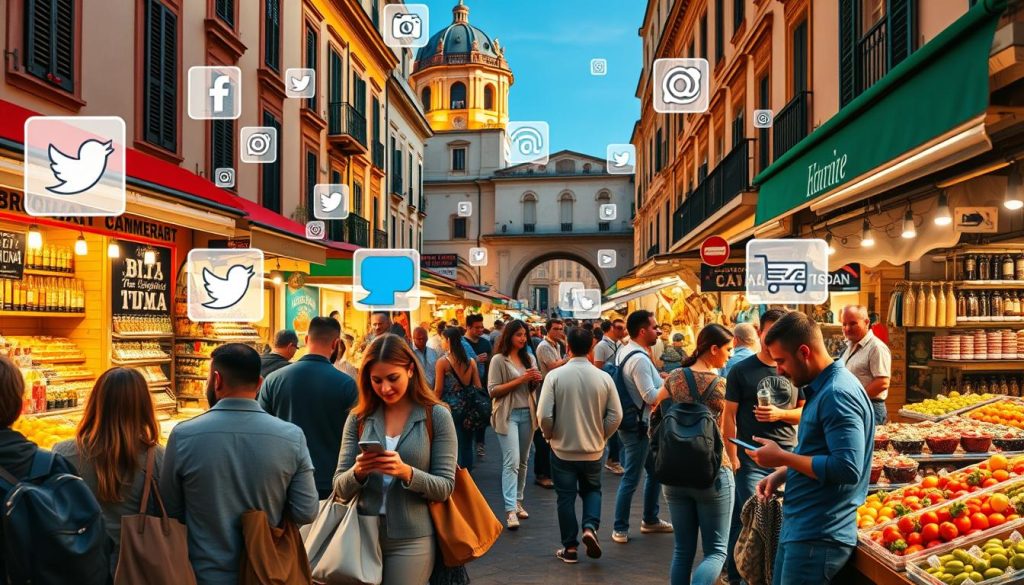
In Italy, social media has a big impact on online shopping. About 75% of people use platforms like YouTube, Facebook, and Instagram. This affects how they shop online.
Platforms like Facebook help 87% of online shoppers find products to buy. Stores that use social media see a 32% boost in sales.
Online shopping in Italy is huge, with nearly 40 million people taking part. Many are influenced by social media. Instagram Shopping, for example, has 130 million users every month.
This shows how social media and online shopping go hand in hand. Italian shoppers often use social media to make their purchases.
As online shopping grows, businesses need to keep up. Social media is key in shaping how people shop. It helps businesses reach more people and stay visible online.
Experts predict big growth in social media sales. They expect it to hit $3 billion by 2026.
The Rise of Mobile Commerce in Italy
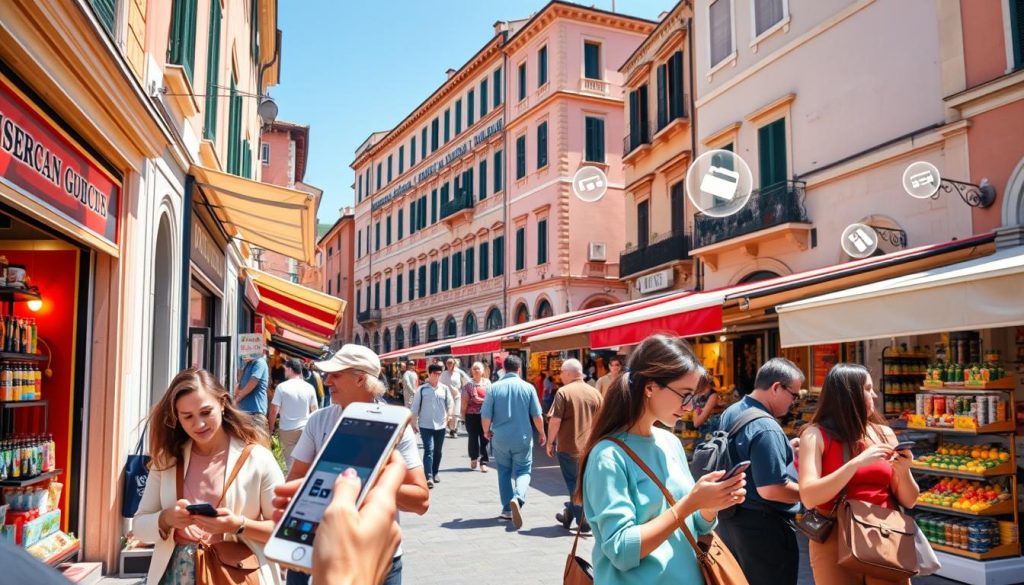
Mobile commerce is booming in Italy, with mobile devices making up about 40% of all sales. This growth shows how mobile shopping is changing the retail scene. More people in Italy are using mobile payments, especially contactless ones, since COVID-19.
Mobile Payment Trends and Consumer Preferences
In Italy, the average person spends around 3 hours and 15 minutes online each day. This gives brands a big chance to connect with customers through mobile. With 3.5 billion mobile users worldwide, it’s expected that soon, three quarters of adults will have a smartphone.
Using personal messages, like push notifications, is key for e-commerce success. This is especially true with the help of advanced tech like machine learning and.
The Italian e-commerce market covers many areas, like fashion, beauty, and electronics. This shows the variety of what people in Italy like to buy online. Working with big e-commerce platforms like PrestaShop and WooCommerce makes mobile shopping better.
Also, mobile apps play a big role in making shopping better for customers and helping businesses make more money.
After the pandemic, local marketplaces are becoming more popular. They use location data to improve their services. Companies using social media for ads are more likely to connect with their audience, fitting in with today’s mobile payment trends.
Key Players in the Italian Digital Marketing Sector
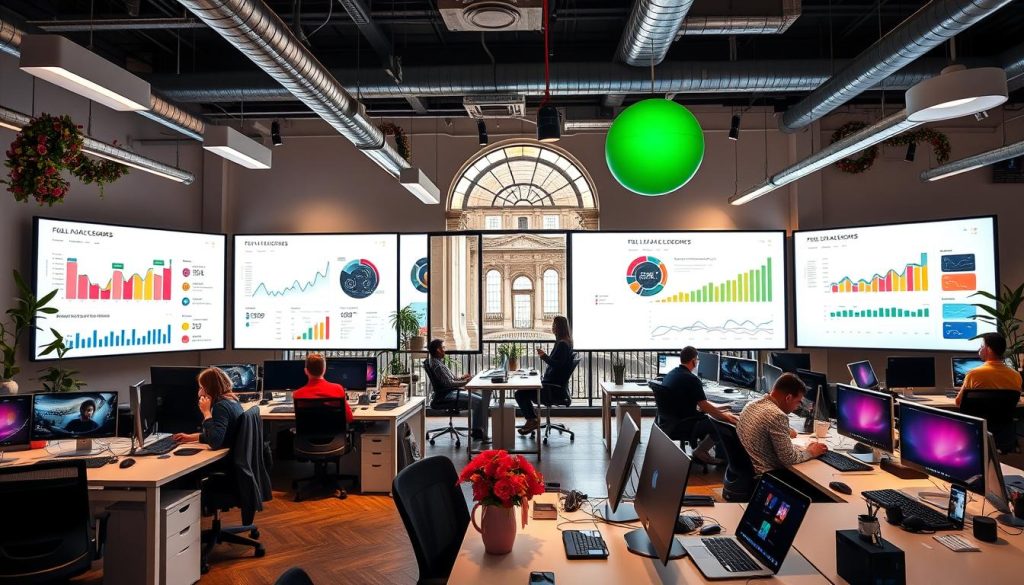
The digital marketing scene in Italy is filled with key players online. These include innovative digital marketing agencies Italy. They use different strategies to meet the growing need for digital advertising solutions.
Koala Rank, based in Firenze, offers services from $29 to $45 per hour. They handle SEO and social media management. Digital Silk, in Milan, charges more, between $100 to $149 per hour. This shows their premium service to clients.
echoVME Digital is a great choice for small businesses in Italy. They charge less than $25 per hour. Their location in Cologna Veneta helps them reach regional markets effectively.
WebConne8, in Grottaferrata, Rome, charges between $25 and $49 per hour. This makes them a good choice for local clients looking for strong digital marketing solutions.
- Midsummer, in Cagliari, charges from $50 to $99 per hour. They focus on creating detailed marketing strategies for their clients.
- Growth Rocket Model Agency, in Arezzo, charges between $100 and $149 per hour. This shows their high-end service provision.
- SEO Performance, in Pescara, offers services from $25 to $49 per hour. This makes them a cost-effective choice for local businesses.
- Online Services Provider, with its base in Alphaville, provides a range of services at competitive rates. They appeal to a wide range of clients.
- Ploomia, in Rome, is also part of this competitive market. However, specific pricing details are not available.
As competition grows, these marketing firms Italy take a holistic approach. They blend branding with value creation. This keeps them at the forefront of a fast-changing market.
Emerging Digital Advertising Trends in Italy

Digital advertising in Italy is changing fast. Businesses are now using many advertising channels to reach their audience better. They focus on data-driven campaigns and keep up with the digital world.
This change shows how key it is to know what people want. Using different platforms helps stay ahead in the game.
Popular Advertising Channels and Strategies
Social media is now a big deal for ads, especially in Italy. It’s all about targeted ads that hit the right people. A big chunk of marketing budgets goes to social media, showing it’s where people want to see ads.
Also, 86% of Italian workers need better digital skills for their jobs. This means they could do better in digital marketing if they had the right training.
Programmatic ads are getting popular too. They make buying and selling ads easier and smarter. Ads are placed better because they know what people like. Younger people are more into targeted ads, so businesses need to keep up with them.
The Role of International Retailing in Italy

International retailing is changing the Italian e-commerce scene. Retail e-commerce sales in Italy are expected to grow a lot from 2018 to 2023. This growth is due to more people buying from foreign brands.
About 85% of Italians, or 50 million people, use the internet. This gives international e-commerce in Italy a big customer base. Italian shoppers prefer brands from Germany, the UK, and China, making cross-border sales popular.
The Italian retail market is growing fast. It was worth US$ 468.73 billion in 2023 and is expected to reach US$ 587.43 billion by 2032. This shows a CAGR of 2.46% from 2024-2032. This growth offers chances for UK businesses to work with Italian tastes.
UNIQLO’s move into Italy shows more interest in unique shopping experiences. The Italian retail sector is also looking to become more digital. This change will make shopping easier and more innovative, affecting global retailing.
Convenience stores are expected to grow a lot in value and number. This shows how shopping habits are changing towards quicker and easier experiences. With U.S. exports to Italy at $117 billion in 2022, international retailers will likely boost cross-border sales and market presence.
Impact of Government Initiatives on Digital Growth

The Italian government is working hard to boost digital growth. They aim to improve the country’s digital setup. The National Recovery and Resilience Plan is a key part of this effort. It helps Italy tackle big labour market issues.
The New Skills Plan brings together government and businesses. It’s all about learning new skills and keeping up with the times. About 15% of Italians lack basic digital skills. It’s important to close this gap for everyone to enjoy e-commerce and technology.
Tools like Skills Intelligence Emilia-Romagna help with job planning. The Lombardy labour market dashboard gives up-to-date info on jobs. These tools help businesses make smart choices in the digital world.
Investing in digital infrastructure makes businesses better connected. Government support for startups and digital marketing is paying off. It’s making Italy’s e-commerce sector grow even more.
Legal and Regulatory Framework for E-commerce

The legal setup for e-commerce in Italy is based on several rules. These rules help guide online businesses. Companies selling to consumers must follow laws that ensure clear information and communication.
The Italian E-commerce Decree requires online sellers to share key details before a sale is final. This includes information about the goods, prices, and the right to cancel within 14 days. It’s also important to protect customer data and allow people to opt out of unwanted messages. Clear pricing helps build trust with online shoppers.
Understanding Consumer Protection Laws
Italy’s consumer protection laws aim to protect buyers and improve their online shopping. They give buyers the right to cancel purchases without reason or extra costs within 14 days. Laws also ban misleading ads and require accurate product info.
The Digital Services Act and the Digital Markets Act add to these rules. They help make the internet safer and hold big platforms accountable. As laws change, businesses must stay updated to avoid legal issues.
Utilising Data Analytics for Market Insights

Data analytics in Italy is key for businesses wanting to understand the market better. In Italy, most businesses are small and medium-sized, making up 99.9% of all companies. This makes data analytics crucial for these businesses to quickly check their operations and predict market trends. It helps them make informed decisions.
The pandemic has made many SMEs turn to digital technologies. This change helps them deal with the challenges of today’s business world.
Importance of Marketing Automation Tools
Marketing automation tools are vital for SMEs to get the most out of data analytics. These tools help businesses improve their marketing, making customers happier and more engaged. They also help in managing resources better and planning strategically, keeping firms competitive.
Investing in technology is also important for marketing success. SMEs that use these tools see big improvements in how they work and their market performance.
The Future of Digital Marketing in Italy
The future of digital marketing in Italy looks bright, with fast tech growth and changing consumer habits. Companies are using AI to make customer experiences more personal. This means better understanding of what people do online and how they interact on social media.
There’s also a big push for voice search and visual search, making marketers keep up with new trends. This is all part of a bigger shift in how we market online.
Short videos are becoming more popular, making brands focus on quick, catchy messages. This is especially true on Instagram and TikTok. Live streaming and webinars are also key for connecting with people in real time, especially after the pandemic.
Italy is investing in digital marketing through plans like the National Recovery and Resilience Plan. This plan helps fund digital projects and improve digital skills in the workforce. Keeping up with these trends will help Italian businesses stay ahead in the fast-changing online world.









